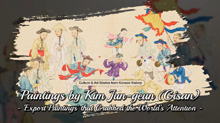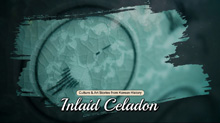The Story of Culture and Arts
- Image resource of Korean history
- Documents from History TextBooks
- Culture & Art Stories from Korean History
- Culture & Art Stories from Korean History - Korean
- National Institute of Korean History
- History net
- About the site
- Introduce
-
Numerous topics related to Korean culture and art are mentioned in middle and high school national history textbooks, but most of them are briefly described by era, making it difficult to understand their concepts, transition processes, and characteristics.
<Culture & Art Stories from Korean History> produces and provides video materials based on expert commentary on the flow, change process, characteristics and characteristics of each major topic in the field of culture and art in Korean history.

Scenario
Goryeo-period celadon, glimmering like delicate green jade. Goryeo celadon developed independently after celadon-making techniques were introduced to Korea from China in the late 10th century.
A unique style of Goryeo celadon emerged between the end of the 12th century and the early 13th century. That style was inlaid celadon, considered the essence of Goryeo art.
Born from the gradual advancement of celadon-making techniques, inlaid celadon differs from standard incised or relief designs in that it features smooth, well-defined patterns. But how were these patterns made?
The inlay pattern is completed through a number of steps. First, the bowl must be molded out of clay, and then the design is etched on. The etched patterns are then filled with white clay. After the bowl has slightly dried, the clay is carefully scratched off. The design is then filled with red clay to create black. This clay is scratched off again when dry.
Different clay is inlaid one after another to complete the design. After a light firing, a glaze is applied, and then it is baked again at a higher temperature. Through these steps, an elaborate celadon vase is born with clear black and white patterns.
The inlay technique is a decorative process used primarily in metalwork crafts across Eurasia, including China. But Goryeo potters applied it to pottery.
However, unlike in contemporaneous China, where designs emphasized color and shapes, in Goryeo, inlaid celadon featured crisp black and white lines that harmonized with intricate designs, displaying its unique beauty.
Celadon Inlaid with the Heart of the Goryeo People
After the military coup in Goryeo in 1170, it is understood that these pieces were made according to the lavish tastes of the ruling class at the time. These pieces captured the hearts of the aristocratic elite since the designs resembled the dreams of the Goryeo people who sought to live in harmony with nature.
Wild chrysanthemums symbolizing a unity with nature. Floating clouds and flying cranes set against a sky-blue background. These designs expressed the hearts of the Goryeo people who dreamed of eternity.
Inlaid celadon, a symbol of advanced celadon techniques and an item beloved by nobility. As such, the government controlled its production and boasted of its premium quality.
However, celadon’s decline began slowly in the first half of the 14th century. In the second half, when foreign invasions intensified, the industry was struck a critical blow.
Coastal areas, where celadon kilns were usually located, saw the most attacks. And when royal authority weakened, it became more difficult to produce high-quality inlaid celadon. This led gradually to the end of the inlaid celadon era.
However, amidst the decline of inlaid celadon, ceramic kilns moved inland, and celadon masters spread throughout the country. So instead of having low-grade celadon, the base technique of celadon work was taken and used as the foundation for a new kind of pottery, buncheong ware.
[Epilogue]
Inlaid celadon, a seed rooted in Chinese techniques but that blossomed from the innovative spirit and unique sense of beauty of Goryeo artisans.
That evergreen beauty, having lasted for hundreds of years, is recognized not just as a piece of Goryeo-period aristocratic culture but as a world-class work of art.
-------------------------------------
Advisor: Park Jeongmin
Script/Storyboard: Im Seung-yeon
Editor: Jo Eunjeong, Myung Jaerim, Seo Myungwon
Narrator: Mary Katherine Chadwick
Filming: Yoon Jongwon
General Editing: Park Injoon, Lee Seungsin
Illustrations: Kim Jongseok, Shim Hui-young
Recording/Music: Jo Donghyo
Logo: Min Seung-ook
Materials/Resources: National Museum of Korea, Master Potter Kim Yeongsu
English Translation & Editing: Mary Katherine Chadwick, Daniel Kane, Lee Jaeyeol
Production Manager: Yoon Jongwon, Kim Kiwon
Administration: Kim Sanghee
Director: Kim Kiwon
Life & Folklore
22 films-
 Paintings by Kim Jun-geun(Gisan)05:15
Paintings by Kim Jun-geun(Gisan)05:15 -
 Moon Jars03:56
Moon Jars03:56 -
 Inlaid Celadon04:13
Inlaid Celadon04:13 -
 Chaekgeori (or Chaekgado)04:38
Chaekgeori (or Chaekgado)04:38 -
 Earthenware08:28
Earthenware08:28 -
 Taenghwa, or Buddhist Paintings in the Joseon Period08:36
Taenghwa, or Buddhist Paintings in the Joseon Period08:36 -
 Lacquerware09:04
Lacquerware09:04 -
 Dyeing and Weaving08:21
Dyeing and Weaving08:21 -
 Royal Seal, Eobo07:53
Royal Seal, Eobo07:53 -
 Folk paintings07:49
Folk paintings07:49 -
 Korean Genre Paintings10:05
Korean Genre Paintings10:05 -
 Paintings of the Procession of the Joseon Tongsinsa10:09
Paintings of the Procession of the Joseon Tongsinsa10:09 -
 Dongjong, Bronze Bells of Korea08:50
Dongjong, Bronze Bells of Korea08:50 -
 Calligraphy08:32
Calligraphy08:32 -
 White Porcelain08:18
White Porcelain08:18 -
 Buncheong Ware07:48
Buncheong Ware07:48 -
 Goryeo Celadon07:54
Goryeo Celadon07:54 -
 Buddhist Paintings of the Goryeo Dynasty07:57
Buddhist Paintings of the Goryeo Dynasty07:57 -
 Clay Figures, Figurines07:01
Clay Figures, Figurines07:01 -
 Clay Earthenware06:05
Clay Earthenware06:05 -
 Paintings of the Joseon Dynasty08:09
Paintings of the Joseon Dynasty08:09 -
 Statues of the Buddha in Korea09:03
Statues of the Buddha in Korea09:03

